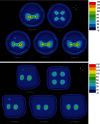How does tooth cusp radius of curvature affect brittle food item processing?
- PMID: 23635495
- PMCID: PMC3673162
- DOI: 10.1098/rsif.2013.0240
How does tooth cusp radius of curvature affect brittle food item processing?
Abstract
Tooth cusp sharpness, measured by radius of curvature (RoC), has been predicted to play a significant role in brittle/hard food item fracture. Here, we set out to test three existing hypotheses about this relationship: namely, the Blunt and Strong Cusp hypotheses, which predict that dull cusps will be most efficient at brittle food item fracture, and the Pointed Cusp hypothesis, which predicts that sharp cusps will be most efficient at brittle food item fracture using a four cusp bunodont molar. We also put forth and test the newly constructed Complex Cusp hypothesis, which predicts that a mixture of dull and sharp cusps will be most efficient at brittle food item fracture. We tested the four hypotheses using finite-element models of four cusped, bunodont molars. When testing the three existing hypotheses, we assumed all cusps had the same level of sharpness (RoC), and gained partial support for the Blunt Cusp hypotheses. We found no support for the Pointed Cusp or Strong Cusp hypotheses. We used the Taguchi sampling method to test the Complex Cusps hypothesis with a morphospace created by independently varying the radii of curvature of the four cusps in the buccolingual and mesiodistal directions. The optimal occlusal morphology for fracturing brittle food items consists of a combination of sharp and dull cusps, which creates high stress concentrations in the food item while stabilizing the food item and keeping the stress concentrations in the enamel low. This model performed better than the Blunt Cusp hypothesis, suggesting a role for optimality in the evolution of cusp form.
Keywords: Taguchi; brittle food item fracture; finite-element analysis; occlusal morphology; radius of curvature; tooth biomechanics.
Figures








Similar articles
-
The effects of relative food item size on optimal tooth cusp sharpness during brittle food item processing.J R Soc Interface. 2014 Dec 6;11(101):20140965. doi: 10.1098/rsif.2014.0965. J R Soc Interface. 2014. PMID: 25320068 Free PMC article.
-
Influence of occlusal contact area on cusp defection and stress distribution.J Contemp Dent Pract. 2014 Nov 1;15(6):699-704. doi: 10.5005/jp-journals-10024-1602. J Contemp Dent Pract. 2014. PMID: 25825093
-
Tooth cusp sharpness as a dietary correlate in great apes.Am J Phys Anthropol. 2014 Feb;153(2):226-35. doi: 10.1002/ajpa.22424. Epub 2013 Nov 13. Am J Phys Anthropol. 2014. PMID: 24227163
-
The effect of early hominin occlusal morphology on the fracturing of hard food items.Anat Rec (Hoboken). 2010 Apr;293(4):594-606. doi: 10.1002/ar.21130. Anat Rec (Hoboken). 2010. PMID: 20235316
-
Associations between Carabelli trait and cusp areas in human permanent maxillary first molars.Am J Phys Anthropol. 2006 Feb;129(2):196-203. doi: 10.1002/ajpa.20271. Am J Phys Anthropol. 2006. PMID: 16323183
Cited by
-
On the evolutionary advantage of multi-cusped teeth.J R Soc Interface. 2016 Aug;13(121):20160374. doi: 10.1098/rsif.2016.0374. J R Soc Interface. 2016. PMID: 27558851 Free PMC article.
-
The effects of femoral metaphyseal morphology on growth plate biomechanics in juvenile chimpanzees and humans.Interface Focus. 2021 Aug 13;11(5):20200092. doi: 10.1098/rsfs.2020.0092. eCollection 2021 Oct 6. Interface Focus. 2021. PMID: 34938436 Free PMC article.
-
Age-related tooth wear differs between forest and savanna primates.PLoS One. 2014 Apr 14;9(4):e94938. doi: 10.1371/journal.pone.0094938. eCollection 2014. PLoS One. 2014. PMID: 24732967 Free PMC article.
-
The effects of relative food item size on optimal tooth cusp sharpness during brittle food item processing.J R Soc Interface. 2014 Dec 6;11(101):20140965. doi: 10.1098/rsif.2014.0965. J R Soc Interface. 2014. PMID: 25320068 Free PMC article.
-
Effects of cropping, smoothing, triangle count, and mesh resolution on 6 dental topographic metrics.PLoS One. 2019 May 6;14(5):e0216229. doi: 10.1371/journal.pone.0216229. eCollection 2019. PLoS One. 2019. PMID: 31059538 Free PMC article.
References
-
- Wood BA, Schroer K. 2012. Reconstructing the diet of an extinct hominin taxon: the role of extant primate models . Int. J. Primatol. 33, 716–74210.1007/s10764-012-9602-7 (doi:10.1007/s10764-012-9602-7) - DOI - DOI
-
- Ungar PS, Sponheimer M. 2011. The diets of early hominins . Science 334, 190–19310.1126/science.1207701 (doi:10.1126/science.1207701) - DOI - DOI - PubMed
-
- Strait DS, et al. In press.Diet and dietary adaptations in early hominins: the hard food perspective .Am. J. Phys. Anthropol . - PubMed
-
- Kay R, Simons E. 1980. The ecology of oligocene African anthropoidea . Int. J. Primatol. 1, 21–3710.1007/BF02692256 (doi:10.1007/BF02692256) - DOI - DOI
-
- Kay RF. 1981. The nut-crackers? A new theory of the adaptations of the Ramapithecinae . Am. J. Phys. Anthropol. 55, 141–15110.1002/ajpa.1330550202 (doi:10.1002/ajpa.1330550202) - DOI - DOI
MeSH terms
LinkOut - more resources
Full Text Sources
Other Literature Sources

